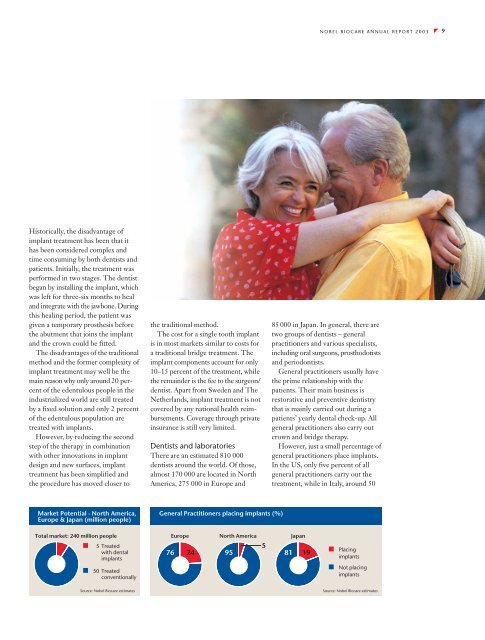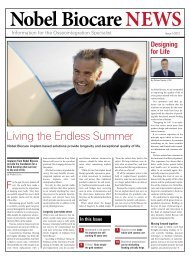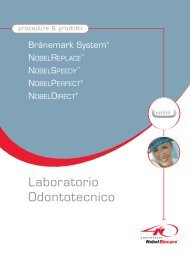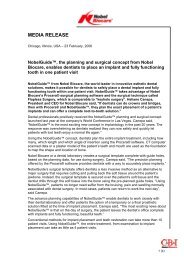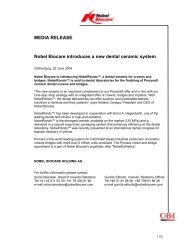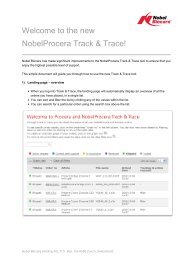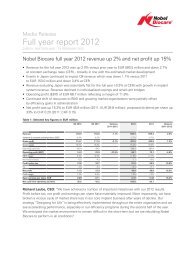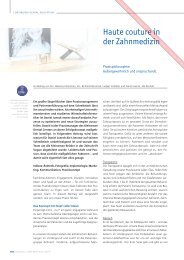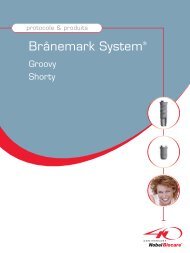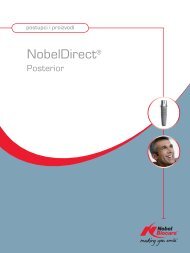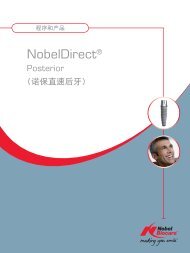Annual Report 2003 - Nobel Biocare Corporate
Annual Report 2003 - Nobel Biocare Corporate
Annual Report 2003 - Nobel Biocare Corporate
- No tags were found...
You also want an ePaper? Increase the reach of your titles
YUMPU automatically turns print PDFs into web optimized ePapers that Google loves.
NOBEL BIOCARE ANNUAL REPORT <strong>2003</strong>9Historically, the disadvantage ofimplant treatment has been that ithas been considered complex andtime consuming by both dentists andpatients. Initially, the treatment wasperformed in two stages. The dentistbegan by installing the implant, whichwas left for three-six months to healand integrate with the jawbone. Duringthis healing period, the patient wasgiven a temporary prosthesis beforethe abutment that joins the implantand the crown could be fitted.The disadvantages of the traditionalmethod and the former complexity ofimplant treatment may well be themain reason why only around 20 percentof the edentulous people in theindustrialized world are still treatedby a fixed solution and only 2 percentof the edentulous population aretreated with implants.However, by reducing the secondstep of the therapy in combinationwith other innovations in implantdesign and new surfaces, implanttreatment has been simplified andthe procedure has moved closer tothe traditional method.The cost for a single tooth implantis in most markets similar to costs fora traditional bridge treatment. Theimplant components account for only10–15 percent of the treatment, whilethe remainder is the fee to the surgeon/dentist. Apart from Sweden and TheNetherlands, implant treatment is notcovered by any national health reimbursements.Coverage through privateinsurance is still very limited.Dentists and laboratoriesThere are an estimated 810 000dentists around the world. Of those,almost 170 000 are located in NorthAmerica, 275 000 in Europe and85 000 in Japan. In general, there aretwo groups of dentists – generalpractitioners and various specialists,including oral surgeons, prosthodotistsand periodontists.General practitioners usually havethe prime relationship with thepatients. Their main business isrestorative and preventive dentistrythat is mainly carried out during apatients’ yearly dental check-up. Allgeneral practitioners also carry outcrown and bridge therapy.However, just a small percentage ofgeneral practitioners place implants.In the US, only five percent of allgeneral practitioners carry out thetreatment, while in Italy, around 50Market Potential - North America,Europe & Japan (million people)General Practitioners placing implants (%)Total market: 240 million people■5 Treatedwith dentalimplants76Europe24North America95581Japan19■ Placingimplants■ 50 Treatedconventionally■ Not placingimplantsSource: <strong>Nobel</strong> <strong>Biocare</strong> estimatesSource: <strong>Nobel</strong> <strong>Biocare</strong> estimates


